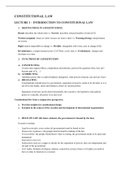College aantekeningen
Constitutional Law Notes
- Instelling
- Haagse Hogeschool (HHS)
Very thorough notes on Constitutional Law taught in Year 1 of the International and European Law program at THUAS. They helped me pass all the exams :) You can also purchase my bundle on International Law which consists of Constitutional Law notes as well as Human Rights and Public International L...
[Meer zien]




